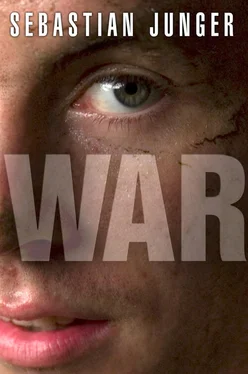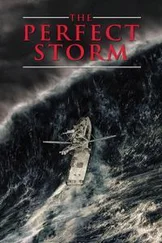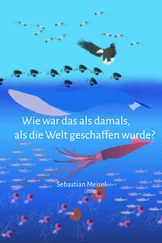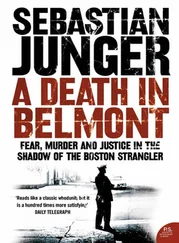That jackass was probably a local teenager who was paid by one of the insurgent groups to fire off a magazine’s worth of ammo at the KOP. The going rate was five dollars a day. He could fire at the base until mortars started coming back at him and then he could drop off the back side of the ridge and be home in twenty minutes. Mobility has always been the default choice of guerrilla fighters because they don’t have access to the kinds of heavy weapons that would slow them down. The fact that networks of highly mobile amateurs can confound — even defeat — a professional army is the only thing that has prevented empires from completely determining the course of history. Whether that is a good thing or not depends on what amateurs you’re talking about — or what empires — but it does mean that you can’t predict the outcome of a war simply by looking at the numbers.
For every technological advantage held by the Americans, the Taliban seemed to have an equivalent or a countermeasure. Apache helicopters have thermal imaging that reveals body heat on the mountainside, so Taliban fighters disappear by covering themselves in a blanket on a warm rock. The Americans use unmanned drones to pinpoint the enemy, but the Taliban can do the same thing by watching the flocks of crows that circle American soldiers, looking for scraps of food. The Americans have virtually unlimited firepower, so the Taliban send only one guy to take on an entire firebase. Whether or not he gets killed, he will have succeeded in gumming up the machine for yet one more day. “Everything in war is simple, but the simplest thing is difficult,” the military theorist Carl von Clausewitz wrote in the 1820s. “The difficulties accumulate and end by producing a kind of friction .”
That friction is the entire goal of the enemy in the valley; in some ways it works even better than killing. Three days later we’re in the mechanics’ bay waiting for the Pech resupply to come in, two Chinooks that run a slow route through the northeast every four days picking up men and dropping off food and ammo. Tim and I are leaving the valley, and the Pech is our way out. The men are on edge because the sniper has been at it all morning, and when the first Chinook comes in, it immediately takes fire from across the valley. A bullet goes up the gunner’s sleeve without breaking his skin and exits through the fuel tank. It was supposedly his first combat mission. After a while a Black Hawk makes it in and drops off the battalion commander, Colonel Ostlund, who strides across the LZ flanked by several officers and two Al Jazeera journalists in powder-blue ballistic vests. One of the officers sees us crouched behind the Hescos and realizes that something must be up. “DO WE HAVE A SITUATION HERE?” he shouts over the rotor noise.
Once again, a couple of guys with rifles have managed to jam up an entire company’s worth of infantry. Ostlund and his staff get back on the Black Hawk and head across the valley for Firebase Vegas. I’m standing next to a tall Marine named Cannon who tells me that the war here is way more intense than most people understand. While we’re talking the shooting starts up again, a staccato hammering that I now recognize as the .50 out at Vegas. Cannon is wearing a radio and gets a communication on the company net that I can’t quite understand.
“Vegas is in a TIC,” he says.
The mortars start firing and an A-10 tilts into its dive and starts working the Abas Ghar with its chain guns. A minute later Cannon’s radio squawks again. “One wounded at Vegas,” he repeats for me, and then, “The platoon sergeant was shot in the neck, he’s not breathing.”
Hunter, who is standing near us, overhears this and walks away. He’s a team leader in First Platoon and knows the sergeant well. His name is Matt Blaskowski, and he’s already received a Silver Star for dragging a wounded comrade to safety during a six-hour firefight in Zabul. A while later Cannon gets another radio update.
“He died on the MEDEVAC bird,” he says.
Neither of us could know this, of course, but Cannon himself would be dead in a couple of weeks, shot through the chest during an ambush outside Aliabad. I was already in New York when I heard the news, and I know this is a stupid point, and obvious, but for some reason that was when I realized how easy it was to go from the living to the dead: one day you hear about some guy getting killed out at Vegas and the next day you’re that same guy for someone else.
Apaches finally come in and clear the upper ridges. Two days later I’m at the Delhi airport waiting for a flight home.
We sleep soundly in our beds because rough men stand ready in the night to visit violence on those who would do us harm.
— Winston Churchill (or George Orwell)
SQUAD AND PLATOON LEADERS GATHER IN AN unfinished brick-and-mortar at the top of the KOP, tense and quiet in the hours before the operation. It’s called Rock Avalanche — a play on the battalion nickname — and will probably be the biggest operation of the deployment. The men will be going into some of the most dangerous places in the valley looking for weapons caches and infiltration routes, and what happens over the course of the next week could well determine the level of combat in the valley for the coming year. The men sit on a low bench next to an orange Atika cement mixer under steel rafters that do not yet have a roof and wait for Kearney to begin the meeting. In the front row is Rougle, the Scout leader, and then Stichter and Patterson and Rice and McDonough and Buno, all from Second Platoon. Men from the other two platoons stand and squat along the walls. They’re in their body armor and most of them have wads of chew under their lower lip. They’re so clean and well-shaven, they could almost pass for rear-base infantry.
Kearney stands before them with a rake in one hand and a sheaf of papers in the other and reading glasses jammed crookedly under the rim of his helmet. At his feet is a sandbox that has been sculpted into a rough three-dimensional model of the Korengal. Cardboard cutouts of Chinooks dangle from strings where the air assaults will go in. The first phase of the operation is a sweep of Yaka Chine, one of the centers of armed resistance in the Korengal. Much of the weaponry that comes into the valley passes through Yaka Chine, as do most of the local commanders, and there is every reason for the men of Battle Company to think they’ll wind up in the fight of their lives. Second Platoon will get dropped off at a landing zone code-named Toucans and move in from the south. First Platoon will get dropped east of town and hook up with Second Platoon near a building complex nicknamed the “Chinese Restaurant.” From a distance, through binoculars, the building’s cornices are ornate and seem to curve upward in a way that suggests the Far East. It’s supposed to be the location of a major weapons depot.
“The other area we’re going to have to focus some of our efforts on is going to be the lumberyard,” Kearney says, pointing with his rake. “The lumberyard is where we believe that there is a lot of the caches, and it’s kind of the battle handover spot for the guys coming from the Chowkay Valley into the Korengal and then pushin’ it through Yaka Chine, where they end up divvying it up to the different subcommanders.”
Piosa comes forward and explains what Second Platoon’s task and purpose will be, then calls on Rice and McDonough and Buno to go into more detail for each squad. Rougle stands up and walks around to the top of the sandbox and points where the Scouts will come in and what their role will be in the operation. The radio call sign for the Scouts is “Wildcat,” and Rougle tells the rest of the company what the Wildcat element will be doing: “We’ll be occupying somewhere in this vicinity,” he says, gesturing with a pointer. “We’ll find a good place where we can set up the Barrett and the twenty-five. We’ll also be holding overwatch on the lumberyard.”
Читать дальше
Конец ознакомительного отрывка
Купить книгу












